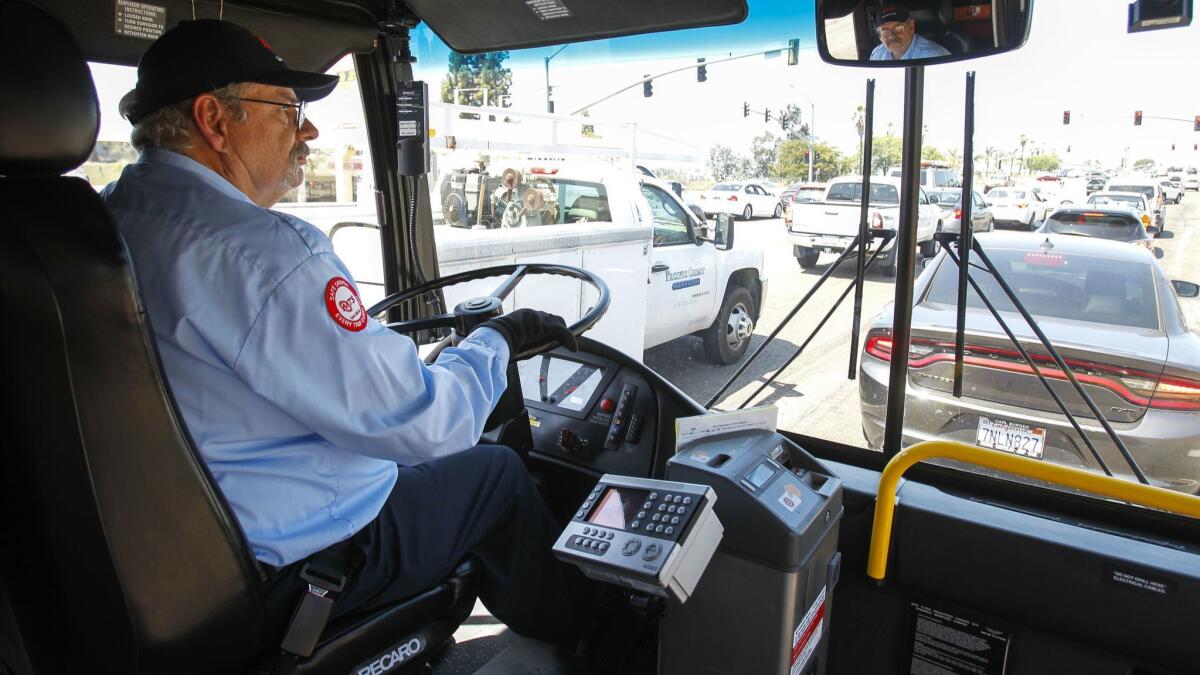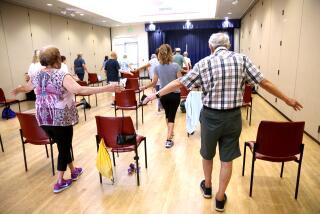More Americans are delaying retirement. But finding jobs when older isn’t so easy

With a master’s degree in computer science and 30 years of experience working for technology companies, Tom Middleton had little doubt he would soon find new employment after losing his job a decade ago as a software engineering manager at Kyocera in San Diego.
How wrong he was.
After two years of submitting more than 300 applications for tech jobs and scoring only an occasional face-to-face interview, the then-59-year-old Middleton became convinced his age was a hindrance. He would hear feedback like “You’re overqualified” and “We can’t pay you what you’re used to.”
As money grew tighter, house payments were missed and 401(k) savings were exhausted, he took minimum-wage jobs at Target and Walmart and tried his hand at income tax preparation. On a whim, he applied for a job as a bus driver — and was hired, now earning less than half his former six-figure salary.
“I had some days where I just wanted to crawl in a hole,” Middleton, now 66, said of his job search. “I thought I’d be a bargain to someone, but they didn’t see it that way.”
A growing share of baby boomers is opting to work well into what traditionally would be their retirement years, but the challenges of remaining employed or reentering the workforce at an older age, even in today’s tight labor market, haven’t necessarily eased.
And even as Labor Department data show more people 55 and older are employed than ever before and have a lower jobless rate — 3.1%, compared with 3.9% for all workers — they remain out of work longer than their younger peers when they lose a job. On average, they’re jobless for about 37 weeks, compared with 25 weeks for workers ages 35 to 44, according to 2017 data from the Bureau of Labor Statistics.
Their hourly pay also starts to decline as they enter their 60s, regardless of how much education they have.
“We are living longer. We are living healthier. We want to work,” said Susan Weinstock, vice president of financial resiliency for the AARP. “We have this labor shortage, and we hear about the skills shortage. Older workers can fill those needs if employers will open themselves up to the idea.”
Why work longer?
Changing demographics and compensation for older Americans have been upending the retirement landscape since the mid-1990s.
In a reversal of a decades-long trend toward earlier retirement, workers ages 55 and older made up 22.4% of the U.S. workforce in 2016, up from just 12% two decades earlier, according to the U.S. Bureau of Labor Statistics. By 2026, when baby boomers will be 62 to 80 years old, that share is expected to rise to 25%.
Workforce participation also has risen sharply, with about 40% of people ages 55 and older either working or actively looking for work today, compared with 30% in 1996. In a survey last year by the Transamerica Center for Retirement Studies, more than half the people queried said they plan to work past age 65 or do not plan to retire.
Economists offer multiple theories about what is driving people to work longer, including improving health, higher education and a shift toward less physically demanding jobs.
The gradual phaseout of traditional employer pensions and a corresponding rise in more volatile 401(k) plans have also discouraged earlier retirements. At the same time, an increase in the Social Security full retirement age (now 66 and rising) has induced people to stay in the workforce longer by rewarding them with higher monthly payments.
“There is a whole set of people who have never really recovered from the Great Recession,” AARP’s Weinstock said. “If your retirement accounts took a hit at that time, it has only been 10 years, and it takes a lifetime to build up those retirement accounts.”
Workers 55 and older have been the fastest-growing segment of the U.S. labor force since 1996, and that trend is expected to continue through 2026, according to the Bureau of Labor Statistics. At the same time, the growth rates for younger age groups aren’t projected to increase much over the next decade.
And as Gary Burtless, a senior fellow in economic studies with the Brookings Institution, noted, there are also some people who simply like their jobs and aren’t ready to stop working.
Lower wages, regardless of education
After 35 years in the construction industry, David Sapper, now 64, said it felt like a “punch in the gut” when he lost his highly paid management job as part of a downsizing seven years ago.
Recognizing he would have to settle for pay well below his previous six-figure salary, he spent nearly a year looking for work before taking a job he hadn’t envisioned for himself — and that pays much less than his old one.
Wage data assembled by the Federal Reserve Bank of Atlanta show average hourly pay for full-time workers starting to decline after age 60 across all education groups. Those statistics, though, are only for full-time employees and therefore don’t reflect the part-time work many older workers typically take, either by choice or necessity.
For the last six years, Sapper has been a caravan driver for San Diego Zoo Safari Park, escorting visitors on tours that include close-up views of giraffes, rhinos and antelopes. Since joining the park, he has worked his way up to nearly 40 hours a week, earning $45,000 to $50,000 a year, he said.
Sapper acknowledged that his wife’s job as a school administrator enabled him to take a significant pay cut, but he also said working at Safari Park has meant much less stress in his life.
“I can now finally sleep at night and go to work happy and not be walking through the door dreading how am I going to make up for a half-million-dollar overrun on a construction job,” he said.
Ellyn Terry, economic policy specialist with the Atlanta Federal Reserve Bank, surmises that one reason for the drop in pay that some workers experience as they age may have to do with reduced productivity.
“There’s economic theory that says prime productivity declines close to the end of our careers,” she said. “Productivity is generally associated with wages; that is, the more you can produce, the more you will get paid. Lower wages among older individuals may also reflect people switching to less intensive jobs.”
She is less convinced, though, that the data suggest age discrimination.
“An economist would argue that age discrimination should not exist, that when an employer wants the best person at the best price they’re not going to willy-nilly use age unless it’s related to something else correlated with worker productivity and they have nothing else to go on,” Terry said.
Proving discrimination is tough
Greg Locke, 60, says he saw signs of bias while looking for work recently. After 21 years in the Marines, Locke earned a master’s degree in business management from San Diego State University and started a second career working for the County of San Diego in the early 2000s.
In June of last year, he retired as real estate telecommunications development project manager, took a few months off and then began looking for work again. During a few of the six interviews he had, Locke said, he was asked how he would interact with younger workers.
“I have to wonder if younger workers were also asked how they would interact with older workers,” he said. He eventually landed a job with a company that didn’t ask that question.
Proving discrimination is difficult, especially in instances where someone does not get hired for a job and age bias is the suspected reason.
Often cited as evidence that age discrimination does indeed exist is research conducted by a trio of economists who in 2015 sent out some 40,000 applications with fictitious resumes for about 13,000 largely low-skilled positions, such as retail sales clerks, janitors and administrative assistants. The resumes were nearly identical except for age and gender.
It turned out that callback rates were higher among younger applicants than their older counterparts, providing “compelling evidence that older workers experience age discrimination in hiring in the lower-skilled types of jobs the experiment covers,” the authors said.
Instances of age discrimination were most noticeable among older women, said coauthor David Neumark, economics professor at UC Irvine and a visiting scholar at the Federal Reserve Bank of San Francisco.
Still, Neumark acknowledges that proof of discrimination remains elusive. “My point is simply, it’s complicated,” he said. “It’s better to be an older worker now than it was in 2010, and it’s better to be a black worker and an ex-felon because employers have fewer workers to choose from to hire. But it’s about the employment cycle, so right now it’s a little easier for these workers finding work, but we’re at the end of a very long recovery.”
There remains a strong perception among the graying workforce that their age is working against them. A 2017 survey commissioned by AARP found that 3 in 5 workers over age 45 have experienced or seen age discrimination in the workplace.
Laurie McCann, senior attorney with the AARP Foundation, said employers these days are savvy enough to “not leave the smoking gun around” that would clearly show age discrimination, but that doesn’t mean there aren’t more subtle instances of ageism in the hiring process.
“Some indications are asking that people be recent graduates. We’re also seeing some jobs where people have to be a digital native, which is someone who grew up using the internet,” McCann said.
Age discrimination complaints filed with the Equal Employment Opportunity Commission totaled more than 18,000 last year, although the number has been trending downward since the recession, when they peaked at more than 24,000. It is not atypical for such complaints to ebb and flow with the economic cycle.
Potential bias against older workers could derail policies aimed at encouraging baby boomers to work longer — one of the best options for keeping the nation’s labor force vibrant.
That’s important because labor force participation among people ages 16 to 24 has been declining since the 1990s. Moreover, employment for workers ages 25 to 54 was stagnant most of the last decade. It was not until this year that jobs in this age group finally returned to pre-recession levels.
Meanwhile, the leading edge of the baby boom generation — some 76 million people born between 1946 and 1964 — is now 72 years old. “Ten thousand baby boomers are retiring every day,” AARP’s Weinstock said. “That’s a company’s institutional knowledge walking out the door.”
The changing job search process
For some older workers, particularly those who worked for one company for many years, trying to find a new job is daunting.
The job search process has moved online, with job boards such as Indeed and ZipRecruiter making it easy to find and apply for all sorts of jobs. But often these efforts prove fruitless, with no feedback whatsoever to applicants.
Kim Selznick, 64, worked as an accountant/administrator for an alternative investment firm for the past 21 years. In April, she was laid off, and she’s struggling to find another job.
“It was suggested that I get on LinkedIn, find people to connect with, then find people that they are connected with,” she said. “That is where I have a hard time, asking people for help and making those connections.”
Yet that’s what it takes to get an employer’s attention in an era of online applications, said Kyle Houston, San Diego branch manager for staffing and consulting firm Robert Half Technology.
“My first bit of advice is to stop applying through job boards,” he said. “That whole adage, ‘it’s not what you know but who you know,’ still rings true.”
Weisberg and Freeman write for the San Diego Union-Tribune.
More to Read
Inside the business of entertainment
The Wide Shot brings you news, analysis and insights on everything from streaming wars to production — and what it all means for the future.
You may occasionally receive promotional content from the Los Angeles Times.












